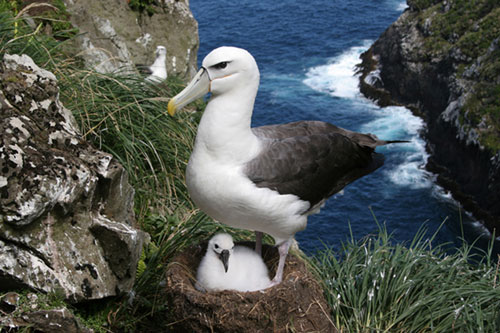Edward Abraham and Finlay Thompson (Dragonfly Science, Wellington, New Zealand) have published recently on the numbers of seabirds killed by New Zealand fisheries over the period 2002-03 to 2008-09 in a report to the New Zealand Ministry of Fisheries.
The paper's Executive Summary follows:
"Seabirds are caught during commercial fishing, most frequently by being hooked during longlining, caught in trawl nets, or struck by trawl warps. In order to understand the impact of fishing on seabird species, estimates of the total mortality from fishing activity must be obtained. In New Zealand commercial fisheries, government observers are present on some vessels, and they record any captures of seabirds and other protected species that occur.
Generalized linear models were used to estimate total captures of seabirds by trawl and longline methods from the observer data. Captures were estimated for trawl, bottom longline, and surface longline fisheries, for the 2002-03 to 2008-09 fishing years (with some models extending back to 1998-99). The estimates were for fishing within the outer boundary of New Zealand Exclusive Economic Zone (EEZ). Statistical models were built of captures of five species groups: white-capped albatross (Thalassarche steadi), sooty shearwater (Puffinus griseus), white-chinned petrel (Procellaria aequinoctialis), other albatross species, and other birds. The models were fitted using Bayesian methods, with the captures represented as samples from a negative binomial distribution.
The total number of seabirds that were estimated to have been caught within New Zealand waters during the 2008-09 fishing year was 3224 (95% c.i.: 2520 to 4412). Of the total estimated captures, 27.5% were albatross species, with the remainder being petrels and shearwaters. The estimate of seabird captures includes captures in all surface longline fishing, in all trawl fishing other than fishing targeting inshore species, in large-vessel (over 34 m long) bottom longline fisheries, and in small vessel bottom longline fisheries targeting snapper in the northern area (FMA1). Observer coverage in the other trawl and longline fisheries was too low to allow for seabird bycatch estimates to be made.
There were 1544 (95% c.i.: 1294 to 1892) estimated seabird captures in offshore trawl fisheries, 591 (95% c.i.: 351 to 987) estimated captures in surface longline fisheries, and 1088 (95% c.i.: 559 to 2719) estimated captures in the bottom longline fisheries for which estimates were made. Of the five species groups used for the modelling, the other birds and other albatross groups had the highest number of estimated captures during 2008-09 (mean estimates of 1207 and 618 captures, respectively). In this year there were also mean estimated captures of 528 sooty shearwaters, 269 white-capped albatrosses, and 601 white-chinned petrels. The results from the estimation were broadly comparable with results from other projects that have estimated seabird bycatch in New Zealand fisheries. An exception was with seabird captures in large-vessel bottom longline fisheries: in this fishery observer coverage has been biased to vessels that use integrated weight lines. Estimation methods that do not take this into account tend to underestimate seabird bycatch in this fishery. Improving observer coverage of the vessels that do not use integrated longline would reduce the uncertainty in the estimates of seabird bycatch in bottom longline fisheries.

White-capped Albatross and chick
Photography by David Thompson
Across all included fisheries, there was a significant decrease in the total number of birds caught between 2002-03 and 2008-09, with the total number of captures falling by 47.6% between the 2002-03 and 2008-09 fishing years. This fall was associated with declines in effort in trawl, bottom longline, and surface longline fisheries. Estimated seabird captures increased by 29.3% between 2007-08 and 2008-09. This increase occurred for a range of seabird species, in a range of different fisheries, despite an ongoing decline in the effort. The reasons for this increase are unclear.
The statistical modelling gives insight into the performance of mitigation measures during routine fishing. In large-vessel bottom longline fisheries, the use of integrated weight line was associated with a reduction in the white-chinned petrel capture rate by 87.2% (95% c.i.: 40.6to 97.6). In 2008-09, only 39% of the effort by large bottom-longline vessels was carried out using integrated weight line. In the squid fishery, the capture rate of white-capped albatross fell to 47.1% (95% c.i.: 20.9 to 98.8) of what it was before the introduction of mandatory warp mitigation in January 2006. The statistical models also showed that seabirds are more likely to be caught in surface longline fisheries during nights close to full moon, than on other nights. Specifically, other albatrosses and other birds were each over 3 times more likely to be caught in surface longline fisheries when the illumination of the moon's disk was more than 90%.
The estimation was based on observer data, and the resulting estimates may be interpreted as the number of captures that would have been reported if there were observers on every vessel. No allowance was made for under-reporting (caused by observers not being able to monitor all fishing activity during observed trips), or cryptic fatalities (caused by birds being killed by the fishing activity, but without the body being brought on board the vessel). In this report, the population consequences of fishing-related seabird fatalities were not considered."
Reference:
Abraham, E.R. & Thompson, F.N. 2011. Estimated capture of seabirds in New Zealand trawl and longline fisheries, 2002-03 to 2008-09. New Zealand Aquatic Environment and Biodiversity Report No. 79. 74 pp.
John Cooper, ACAP Information Officer, 8 March 2012

 English
English  Français
Français  Español
Español